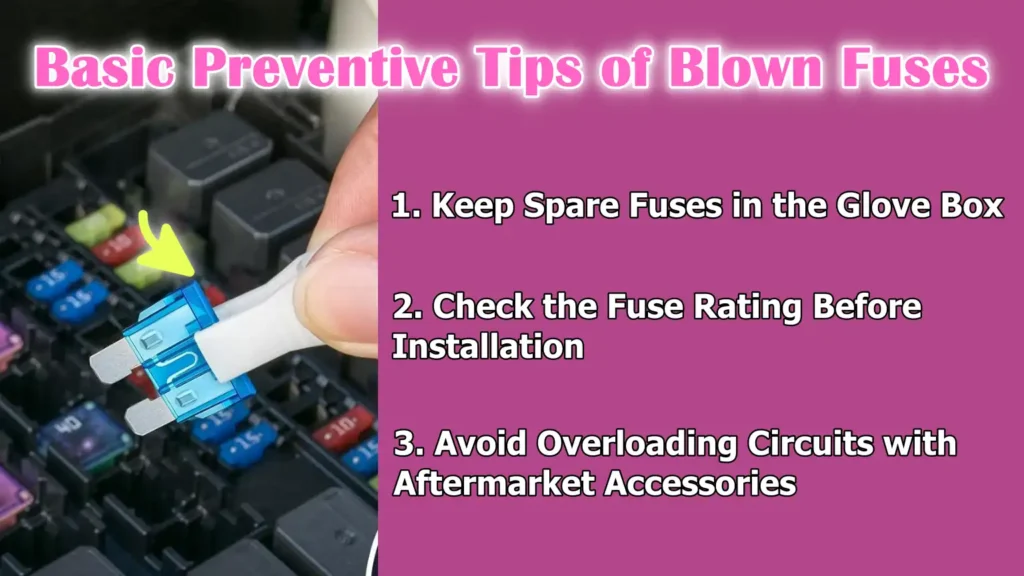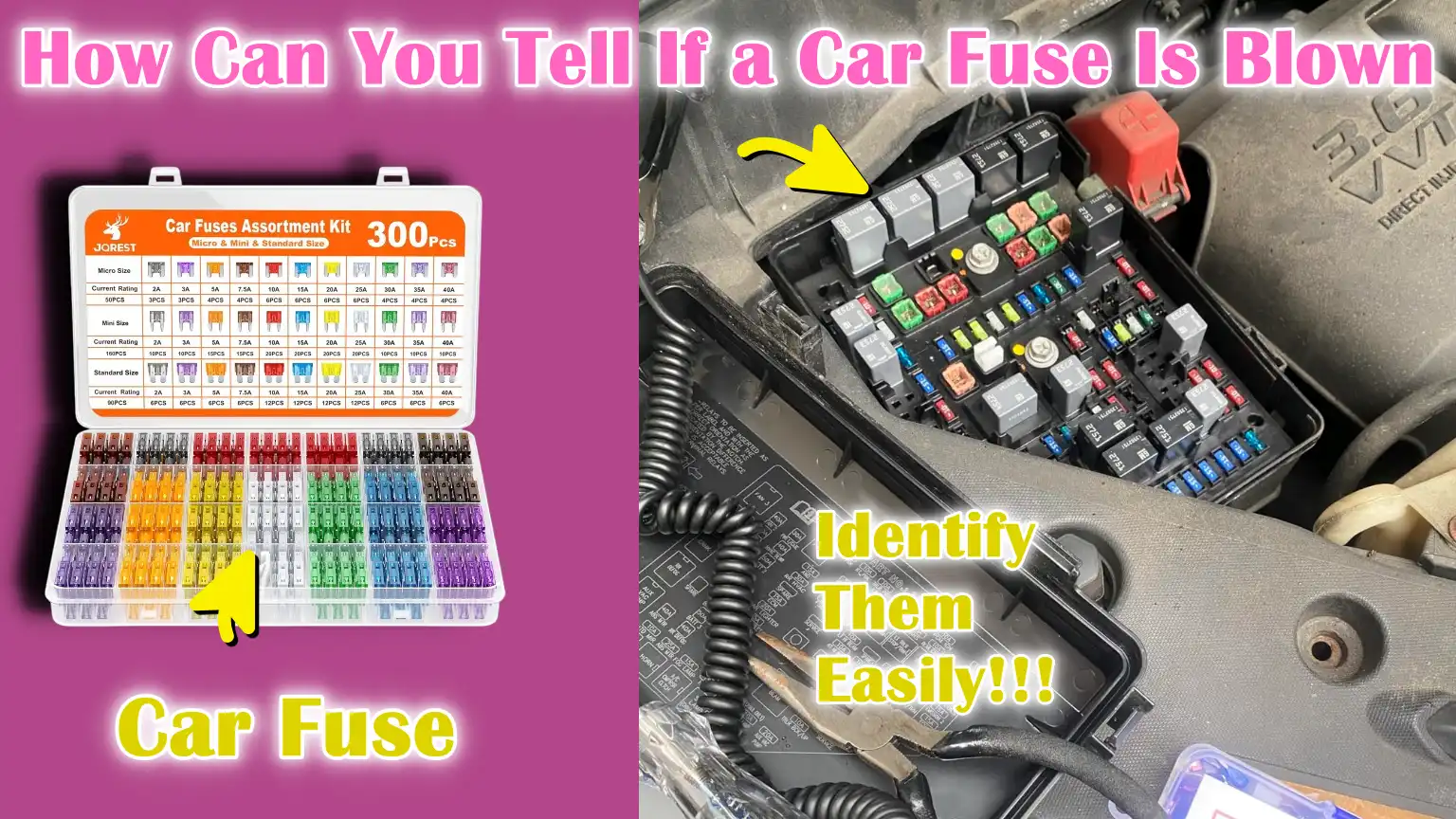Written By: Don Dodi
Fact Checked By: Kristen Brown
Reviewed By: Diego Rosenberg
It is the fact that car fuses are tiny, but they can disrupt workings of your headlights, radio or even power windows: as they are actually safety guards for your car that protects wires and electronics from damage which is simply caused by too much electricity.
So, basically every electrical components in a vehicle, from headlights and air conditioning, actually relies on the proper functioning of fuses.
And fuse guards them, as they automatically “blows” or simply stops working when too much electrical current flows through and in that way this tiny fuse prevents damage to wires and components and really reduces the risk of fire as well.
But, the thing is How Can You Tell If a Car Fuse Is Blown, the signs are quick and really simple, as modern cars often have multiple fuse boxes with color-coded and numbered fuses as well, so checking them doesn’t have to be that complicated.
And there are simple signs such as: malfunctioning electrical component, a flickering light or visible burn marks: so with these simple signs and methods you can easily identify a blown fuse yourself safely and then replace them to keep the electrical system working.
What are the Common Symptoms of Car Fuses
1. Electrical Equipment Failure
The most obvious sign of a blown fuse in a car is when an electrical device stops working altogether.
This could be common problems like your car radio not turning on, interior lights not working, or critical systems like headlights or windshield wipers not working.
Fuses are designed to protect these devices by interrupting the flow of excess electricity.
When a fuse fails, it cuts off power to the circuit it protects, causing the affected device to stop working.
Early detection can prevent further electrical problems and ensure your car remains safe to drive.
2. Multiple Systems Failing Simultaneously
Sometimes a single fuse can affect more than one device at the same time.
This is because some fuses control multiple devices in the same electrical circuit.
For example, a blown fuse can cause your cigarette lighter, dashboard lights and infotainment system to stop working simultaneously.
When multiple systems malfunction simultaneously, it’s a clear sign that the problem isn’t with a single device, but rather a faulty fuse.
Understanding this can save time diagnosing the issue and avoid unnecessary replacements.
3. Flickering or Intermittent Functioning
A blown or damaged fuse doesn’t always completely shut down an electrical device; sometimes it causes flickering or intermittent function.
This means a light may suddenly flicker or brighten, or a radio may turn on and off unexpectedly.
These erratic behaviors indicate that the circuit isn’t receiving consistent power, a common sign of a weak or partially damaged fuse.
Identifying this symptom can help prevent sudden electrical failures while driving.
4. Burning smell or visible burn marks near the fuse box
In more severe cases, a blown fuse may leave visual or olfactory signs.
Sometimes a burnt or melted fuse can be seen through the fuse housing and the fuse or the area around it may also be dark in color.
Additionally, a burning smell coming from the fuse box area may indicate that a fuse has blown due to excessive current.
It’s important to address these signs immediately to prevent further damage to your car’s electrical system and reduce the risk of a fire.
How to Find Fuse Box Location
1. Specific Fuse Box Locations
Car fuse boxes are designed to be easily accessible, but they are usually located in locations protected from accidental damage or moisture.
Most vehicles have a fuse box located under the dashboard on the driver’s side, often near the steering column, which is convenient for checking frequently used circuits such as lights and interior accessories.
Another common location is under the hood, usually near the battery or on the side of the engine compartment, where fuses for major engine and electrical systems are located.
Some cars have additional fuse boxes on the side of the dashboard or behind a panel near the glove box, providing easy access to circuits for entertainment systems or accessories.
Knowing these specific locations helps you quickly find the correct fuse box without any guesswork, saving time and reducing the risk of damaging components.
2. Refer to the Owner’s Manual or Fuse Box Diagram
Every vehicle comes with an owner’s manual that provides detailed information about fuse boxes, including their locations, the circuits they protect and the amperage rating of each fuse.
Most fuse boxes have a diagram printed on the inside cover or as a separate chart, showing which fuse corresponds to each electrical component.
Referring to these diagrams is important to ensure you are checking or replacing the correct fuse and not damaging unrelated circuits.
This step is specially useful for modern cars, which may have multiple fuse boxes containing dozens of fuses, each with a different purpose.
Using a manual or diagram keeps the process accurate, safe and efficient.
Tools
| Tool | Purpose | How to Use It |
|---|---|---|
| Fuse Puller or Needle-Nose Pliers | Helps to safely remove fuses from the fuse box, without damaging them or surrounding components. | Gently grasp the fuse and pull it straight out of its slot. |
| Flashlight | Provides light in dim or hard-to-reach areas, specially under the dashboard or in the engine compartment. | Shine a light directly on the fuse box and fuse for a clear view. |
| Fuse Tester or Multimeter | Allows you to check if a fuse is blown by testing electrical continuity or voltage. | Insert the fuse into the tester or touch the multimeter probes to both fuse terminals. |
How to Visually Inspect Blown Fuse
1. Carefully Removing a Suspect Fuses
Before inspecting a fuse, it’s important to turn off the car’s ignition to avoid any electrical accidents.
Using a fuse puller or needle-nose pliers, carefully remove the fuse from its slot without bending or damaging it.
Pulling it straight out prevents damaging the fuse terminals or surrounding wires.
Being careful during removal ensures that the fuse can be properly inspected and, if undamaged, can be safely reused.
2. Remove the Fuse
After removing the fuse, hold it up to a bright light or flashlight.
This makes it easier to see the condition of the internal metal strip and plastic casing.
Proper lighting is essential, as dim or uneven light can make it difficult to see small cracks or discoloration.
Closely inspecting the fuse can help detect early signs of a malfunction that may not immediately affect the electrical component.
3. Check for a Broken Metal Strip Inside
The most reliable visual sign of a blown fuse is a broken or melted metal strip inside the fuse.
This strip conducts electricity through the fuse and when it breaks due to excessive current, the circuit is interrupted.
A continuous strip indicates that the fuse is still working, while any gaps, breaks, or burns in the metal confirm that the fuse has blown and needs to be replaced.
4. Check for Black or Burnt Spots
Another sign of a blown fuse is the appearance of black or burnt spots inside the fuse.
The plastic casing may appear black or smoky due to overheating.
This colorless spot indicates that the fuse has absorbed more electricity than it can handle.
Early detection can prevent damage to other components and avoid potential safety hazards such as electrical fires.
5. Check for a Melted Plastic Cover
In severe cases, the plastic cover of the fuse may melt or become distorted.
This usually occurs when a sudden electrical current flows through the fuse.
A melted cover is a clear sign that the fuse is no longer safe for use and needs to be replaced immediately.
Inspecting the fuse for these signs ensures the safety and proper functioning of your car’s electrical system.
How to Electrically Test a Fuses
1. Using a Multimeter
Testing a fuse with a multimeter is one of the most reliable ways to determine if it’s working properly.
First, set the multimeter to continuity mode or the lowest resistance setting.
Continuity mode allows the multimeter to beep when the circuit is complete, while resistance mode displays a numerical value indicating whether electricity can flow through the fuse.
Next, touch the multimeter probes to both metal terminals of the fuse.
If the multimeter beeps or shows a low resistance reading, the fuse is still working.
If there’s no beep or the reading shows infinite resistance, the fuse is blown and needs to be replaced.
This method is accurate because it tests the actual electrical path inside the fuse rather than relying solely on visual inspection.
2. Using a Fuse Tester
A fuse tester is a simple tool specifically designed to quickly test fuses.
To use it, insert the fuse into the tester slot according to the tester’s instructions.
Most testers have an indicator light that lights up when the fuse is good.
If the light doesn’t light, it means the fuse is blown and can’t carry power.
Fuse testers are convenient because they respond quickly and reduce the risk of error compared to visual inspection alone.
They are specially useful for people who frequently check fuses in multiple vehicles or work in low-light conditions.
Read More:
How to Replace a Fuse
1. Matching the Amperage Rating
When replacing a fuse, it’s important to use a new fuse with the same amperage rating as the original.
Fuses are color-coded and numbered to indicate their amperage, which represents the maximum current they can safely handle.
Using a fuse with a different rating can reduce circuit safety.
A fuse with a lower rating may blow too quickly, while a fuse with a higher rating may fail to protect the circuit, causing damage to wiring or electrical components.
Ensuring the correct amperage rating is the first step towards a safe and effective replacement.
2. Never Use a Fuses with a Higher Rating
It’s important to avoid using a fuse with a rating higher than the recommended rating.
Overrated fuses allow current to flow through the circuit beyond its designed limit.
This can cause overheating, damage sensitive electronic equipment, or even cause an electrical fire.
Following the manufacturer’s instructions for fuse ratings ensures the safety of your car’s electrical system and reduces the risk of costly repairs or safety hazards.
3. Installing a New Fuse
After selecting the correct fuse, carefully install it in the designated slot.
The fuse should fit snugly without force, ensuring that the metal terminals are in proper contact with the fuse box connector.
A loose fuse can cause intermittent electrical problems or fail to effectively protect the circuit.
Correct installation ensures that the electrical component receives the necessary protection and operates safely.
4. Retesting the Electrical Component
After installing the new fuse, start the car and check the previously damaged component.
Make sure it is functioning properly and regularly.
If the component still doesn’t work, or the new fuse blows immediately, there may be an underlying electrical problem, such as a short circuit or faulty wiring, that requires professional attention.
Testing after replacement confirms that the fuse is installed correctly and that the electrical system is functioning properly.
When You Should Go at Professional
1. Fuses Keep Blowing Even After Replacing a Fuses
If fuses keep blowing repeatedly even after replacing them, this is a clear sign of a serious electrical problem in the circuit.
This could be caused by a short circuit, a damaged wire, or a faulty component drawing excessive current.
Replacing the fuse alone will not solve the underlying problem and repeatedly installing new fuses could worsen the problem or damage the vehicle’s electrical system.
Consulting a professional ensures the cause is properly diagnosed and repaired.
2. Symptoms of Melted Wiring or a Burning Smell
Visible signs of melted wiring or a burning smell near the fuse box or electrical components indicate a serious safety hazard.
These symptoms indicate that excessive current is flowing through the circuit, which could cause a fire or permanent damage to the car’s electronic components.
Professional technicians have the tools and expertise to locate the source of heat or overload, safely repair the wiring and prevent further risk to the vehicle and its occupants.
3. Electrical System Failure Even After Replacing a Fuse
If the affected electrical system continues to malfunction after replacing a fuse, it may indicate a problem beyond a single fuse.
Problems such as faulty relays, corroded connections, or a damaged control module can prevent the circuit from functioning properly.
Seeking professional help ensures a thorough inspection of the entire electrical system, allowing for an accurate diagnosis and effective repairs that restore safe and reliable operation to your vehicle.
Yes, it is true that fuses protect your car by “SACRIFICING” themselves whenever a circuit draws too much current. So, just check the color and amp number on the fuse: as they must match the original one and you can simply identify blown one as many modern fuses have clear housings so you can spot a broken metal strip or dark discoloration as well.[¹]
Basic Preventive Tips of Blown Fuses

1. Keep Spare Fuses in the Glove Box
One of the easiest ways to deal with a blown fuse situation is to keep spare fuses in your car, ideally in the glove box or another easily accessible location.
Having replacement fuses available ensures you can quickly repair important electrical components like headlights, hazard lights, or radios without waiting for a shop or mechanic.
Keeping a small, organized set of fuses with different amperage ratings is useful for both everyday driving and emergency situations.
2. Check the Fuse Rating Before Installation
Before installing a replacement fuse, always ensure it matches the amperage rating of the original fuse.
Fuses are designed to protect circuits by limiting the amount of electrical current passing through them.
Installing a fuse with the wrong rating can cause the fuse to blow prematurely or fail to protect the circuit, potentially damaging wiring or electronic equipment.
Ensuring the correct fuse rating maintains the safety and reliability of your car’s electrical system.
3. Avoid Overloading Circuits with Aftermarket Accessories
Installing aftermarket electrical accessories, such as additional lights, sound systems, or chargers, can increase the current load on your car’s circuits.
Circuit overload can frequently blow fuses or damage wiring and components.
To avoid this, ensure any additional accessories are compatible with the vehicle’s electrical capacity and consider consulting a professional when installing high-power equipment.
Proper planning and careful installation minimize the risk of blown fuses and protect the vehicle’s electrical system.
Conclusion – How Can You Tell If a Car Fuse Is Blown
You should never ignore causes of blown fuse, as it can even lead to the costly repairs or dangerous electrical issues as well.
Fuses are small components, but they play a vital role in protecting your car’s electrical system from damage and preventing potential fire hazards.
By recognizing common symptoms like faulty electrical components, flickering lights, or unusual smells and knowing where and how to check fuses, you can troubleshoot problems quickly and safely.
Using the right tools, like a multimeter or fuse tester, ensures an accurate diagnosis, while replacing fuses with the correct amperage maintains the integrity of your car’s circuits.
Regular preventative measures, like keeping spare fuses and avoiding overloading circuits, can save you time, money and stress.
Mastering these simple steps will not only keep your car’s electronics working reliably, but will also give you the confidence of safe vehicle maintenance.
So, if you still have questions left in mind, please let us known by commenting below.
Frequently Asked Questions
Q1. What is a car fuse and why is it important?
Answer: A car fuse is a small safety device that protects your car’s electrical system from excessive current. Every electrical component in your vehicle, such as lights, radio and power windows, relies on fuses to prevent damage. If too much current is applied to a circuit, the fuse “blows,” or breaks the connection, stopping the flow of current. This prevents wiring from overheating and can prevent serious damage or fire. Replacing a fuse is simple, but crucial to keeping your car safe and running.
Q2. How can I tell if a fuse has blown?
Answer: You can usually tell if a fuse has blown when an electrical component, such as your headlights, radio, or interior lights, stops working. Sometimes multiple systems may malfunction at the same time, or a device may repeatedly turn on and off. In more severe cases, you may notice a burning smell or burn marks near the fuse box. To be sure, you can remove the fuse and inspect the metal strip inside. If it’s broken or burnt, the fuse is blown and needs to be replaced.
Q3. Where is the fuse box located in a car?
Answer: The fuse box can be found in different locations depending on the car model. Common locations include under the dashboard, near the steering column, under the hood near the battery, on the side of the dashboard, or behind the glove box. Most cars have a diagram in the owner’s manual or on the fuse box cover, indicating which fuse controls each electrical component. Consulting the manual helps you quickly locate the correct fuse without causing any damage.
Q4. What tools do I need to check a fuse?
Answer: Basic tools include a fuse puller or needle-nose pliers to safely remove the fuse and a flashlight to see clearly in dim areas. For a more accurate check, you can use a fuse tester or multimeter. These tools help you determine whether a fuse is truly blown or still working. A multimeter can test for continuity or resistance and a fuse tester will tell you immediately whether a fuse is working. These tools make this process safe and reliable.
Q5. How do I test a fuse?
Answer: You can test a fuse visually or electrically. By looking at the fuse, you check if the metal strip inside is broken or burned, or if the plastic cover is melted or blackened. Electrically, you can use a multimeter set to continuity mode to touch both terminals of the fuse. If the meter beeps or shows low resistance, the fuse is fine. If it doesn’t beep or shows infinite resistance, the fuse is blown. A fuse tester works similarly, showing a light if the fuse is working and no light if it’s blown.
Q6. How do I replace a blown fuse?
Answer: To replace a blown fuse, first make sure you use a new fuse with the same amperage rating as the original one. Using a higher rated fuse could damage the electrical system or cause a fire. Firmly insert the new fuse into the correct slot and ensure it’s properly seated. After installation, test the electrical component to ensure it’s working. If the new fuse blows immediately, there may be a serious electrical problem that requires professional attention.
References
[1] Fuseology
https://www.littelfuse.com/assetdocs/littelfuse-fuseology?assetguid=c81c1a21-b903-44b6-b46d-180c48f7c3c5

Guys, I’m a car audio enthusiast and customization expert and I love clear sound and clean installation. Plus, I have spent years helping people build their dream audio setups. And whenever I’m working on cars, I probably listen to music and thinks about the next big upgrade.

